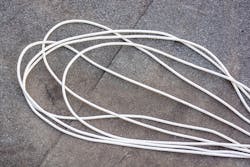Suppose you walk down a stairway and discover a portable cord strung across it. You take a minute to unplug the cord and reroute it to eliminate the tripping hazard. Should you report this as a safety incident?
The answer lies in what is (supposed to be) done with safety incident reports. When management is apprised of the error, they have several options. Which of the following do you think is best?
- Talk with the crew that was using the cord and ask them to explain why this was dangerous and how to do better. This is focused training.
- Note this happened with another crew last week, and recharacterize the problem as more general. Hold general training on portable cord use.
- Do both of the above.
- Do both of the above, plus grow the battery-powered tool collection to reduce the need for portable cords.
But if nobody has gotten hurt, why start a fuss? Because without the fuss, someone is bound to get hurt.
It’s not just cords, of course. Unsafe acts involving ladders (always a top citation by OSHA), chemicals, PPE, lockout/tagout, measuring techniques, and many other aspects of electrical work often claim no victim during the first few incidents. But that is due to luck. And luck eventually runs out.
When employees report safety incidents, no matter how minor an incident might seem, management has the data to see that a particular problem exists, what it is, and how frequently it happens. But they can’t address a safety problem if they don’t even know that it exists.
About the Author

Mark Lamendola
Mark is an expert in maintenance management, having racked up an impressive track record during his time working in the field. He also has extensive knowledge of, and practical expertise with, the National Electrical Code (NEC). Through his consulting business, he provides articles and training materials on electrical topics, specializing in making difficult subjects easy to understand and focusing on the practical aspects of electrical work.
Prior to starting his own business, Mark served as the Technical Editor on EC&M for six years, worked three years in nuclear maintenance, six years as a contract project engineer/project manager, three years as a systems engineer, and three years in plant maintenance management.
Mark earned an AAS degree from Rock Valley College, a BSEET from Columbia Pacific University, and an MBA from Lake Erie College. He’s also completed several related certifications over the years and even was formerly licensed as a Master Electrician. He is a Senior Member of the IEEE and past Chairman of the Kansas City Chapters of both the IEEE and the IEEE Computer Society. Mark also served as the program director for, a board member of, and webmaster of, the Midwest Chapter of the 7x24 Exchange. He has also held memberships with the following organizations: NETA, NFPA, International Association of Webmasters, and Institute of Certified Professional Managers.
